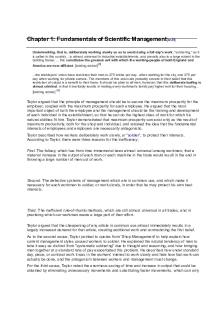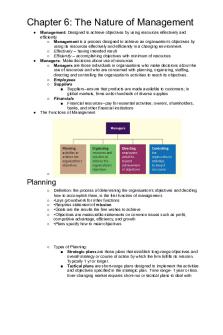Elements OF Classroom Management AND THE Positive Classroom PDF

| Title | Elements OF Classroom Management AND THE Positive Classroom |
|---|---|
| Author | Benedicta Anya |
| Course | Creating Positive Classroom Environments |
| Institution | University of the People |
| Pages | 5 |
| File Size | 98.1 KB |
| File Type | |
| Total Downloads | 111 |
| Total Views | 153 |
Summary
Assignment...
Description
1
ELEMENTS OF CLASSROOM MANAGEMENT AND THE POSITIVE CLASSROOM
Department of Education EDUC 5240: creating positive classroom environment Instructor: Matthew Pettus University of the People June 24th, 2021
2
According to Cini (2017), there are seven areas of teacher responsibility in classroom management:- Classroom Design, Rules, Discipline, Scheduling, Organization, Instructional Technique, Communication. The three most crucial according to me are Discipline, Organization, and Communication. Other elements of classroom management procedures and teaching techniques will coherently fall into place when these central key elements are catered to effectively. It would be most beneficial whether a new teacher or teachers who face difficulties in their classes due to disorderliness master and implement these techniques; and the results will prove to be astounding. Communication: Communication is the most important aspect of classroom management. It is essential to have clear and consistent lines of communication with your administration, colleagues, students and parents. Without it you will lose the respect of peers, the attention of students, and the cooperation of parents. Be responsive to the concerns of others. Be flexible and willing to accommodate reasonable requests. Teachers can effectively motivate students to become high achievers through encouraging words on even their smallest of achievements. Effective communication goes a long way in teaching the students how to learn in relevant, meaningful and memorable manners. Communication in the form of feedback and praise help in keeping the pupils on track. Feedback in the form of verbal exchanges, report cards, emails, teacher comments are always a looked forward to event after each assessment, evaluation examination or test by both the students and their parents. Communication is the third crucial element for effective classroom management. It is very important for an open line of communication to be in place between the teacher, the students and their parents. Effective teachers go out of their way to communicate with their students even after school in personal matters too, and not necessarily pertaining to their subjects only. So the teachers must master ways in which to encourage the areas of strengths of students that they do not become easily self -gratified but carry on building on these; or positively
3
comment on the weaknesses of the students to encourage them to turn these around to make them their strengths. Discipline: Discipline is the expected student behavior during learning engagements in classes. Classroom rules must have concrete consequences. Students will test the limitations of each teacher from the very first day of school. Be firm, fair and consistent. Begin by warning a student and having them confirm their knowledge of the classroom rules. Follow-up continued disruption by issuing demerits, detention, or other official reprimands. New teachers should never, hit, harass, embarrass or yell at students-this is counterproductive, unprofessional and often illegal. Teachers must remember to target the inappropriate behavior of the students and not the students themselves. Being a new teacher I find this aspect one of the crucial elements of Classroom Management to master. Organization: Stay organized inside and out. Keep your student files, assignments, lesson plans and administrative paperwork in order. It sets a good example for your students and keeps you from wasting instructional time looking for materials. Share this system with your students. Post the classroom calendar, homework schedule and assignments on the board. Allow students to see how you take notes. It helps them distinguish irrelevant information from essential details. Encourage self-directed learning by providing students with their own agenda (notebook). You may require students to have their notebooks checked at home or during class. Teachers can imbibe in students the habit to come well- prepared to attend a lesson. Though all seven of Cini’s listed responsibilities are important, the three listed above: rules, discipline, and communication, are the most important as these three set the tone for the rest of the school year. As the entire profession of teaching is multilayered and complex. (Knoster, 2014), a new teacher can easily become overwhelmed with the number of responsibilities and expectations he or she may have within the first month of teaching.
4
However, with these three responsibilities established, the teacher can spend less time on trying to manage the classroom and more time on professional development, refining one’s own content knowledge, and most importantly, more time focusing on the students in the classroom. Challenges a new teacher may face when attempting to master these areas For beginning teachers, or for teachers like myself returning to teaching, the most difficult thing to master is classroom management. Discipline: Limitations of Disciplining Students Not all students in a class may be well-mannered or respectful. There can be some cases of serious disrespect towards teachers and the rules safeguarding students can be a headache for teachers. Communication: lack of communication from students /parents Even when it is the role of teacher to provide students with quality education, the process is only complete with the cooperation and understanding of parents and school management. Parents should be the ideal working partners of teachers to provide the best learning experience for students. If parents are stepping away from their responsibility, it can be tough for teachers to handle at least a few of the students. Organization: lots of paper work to do Unlike in the past when teachers can’t just finish off their syllabus and typically evaluate the students. The situation is more challenging today. They will have to handle multiple roles in the classroom. New teachers are finding it really challenging handling multiple roles as they lack enough time for planning.
5
References Cini, S. (2017). Seven Key Elements for Effective Classroom Management. Retrieved from https://classroom.synonym.com/seven-elements-effective-classroom-management6562940.html Sieberer-Nagler, K. (2016). Effective Classroom-Management & Positive Teaching. English Language Teaching, 9 (1). Retrieved from https://files.eric.ed.gov/fulltext/EJ1087130.pdf Choe, Y. (n.d.). Becoming a positive teacher. Retrieved from http://www.ascd.org/ascd express/vol4/405-newvoices.aspx Knoster, T. (2014). The Teachers Pocket Guide for Effective Classroom Management (2nd ed.). Paul H. Brookes Pub. Co. Ben, J. (2016, September 16). 5 priorities of Classroom Management. Edutopia. https://www.edutopia.org/blog Classroom challenges according to teachers. (n.d.). Google. Retrieved June 21, 2021, from https://www.google.com/amp/s/www.edsys.in...
Similar Free PDFs

PRACTICE OF MANAGEMENT, THE
- 12 Pages
Popular Institutions
- Tinajero National High School - Annex
- Politeknik Caltex Riau
- Yokohama City University
- SGT University
- University of Al-Qadisiyah
- Divine Word College of Vigan
- Techniek College Rotterdam
- Universidade de Santiago
- Universiti Teknologi MARA Cawangan Johor Kampus Pasir Gudang
- Poltekkes Kemenkes Yogyakarta
- Baguio City National High School
- Colegio san marcos
- preparatoria uno
- Centro de Bachillerato Tecnológico Industrial y de Servicios No. 107
- Dalian Maritime University
- Quang Trung Secondary School
- Colegio Tecnológico en Informática
- Corporación Regional de Educación Superior
- Grupo CEDVA
- Dar Al Uloom University
- Centro de Estudios Preuniversitarios de la Universidad Nacional de Ingeniería
- 上智大学
- Aakash International School, Nuna Majara
- San Felipe Neri Catholic School
- Kang Chiao International School - New Taipei City
- Misamis Occidental National High School
- Institución Educativa Escuela Normal Juan Ladrilleros
- Kolehiyo ng Pantukan
- Batanes State College
- Instituto Continental
- Sekolah Menengah Kejuruan Kesehatan Kaltara (Tarakan)
- Colegio de La Inmaculada Concepcion - Cebu














